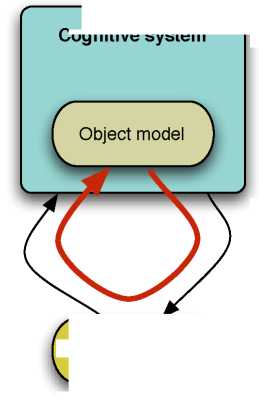
Cognitive system
Object model
Object
Figure 4: System perception implies the continuous update of the models that the
system is employing in the generation of behavior.
mation coming from the inside of the system. Here authors will typically talk about
two clasess of preception, propioception —the sensing of the body— and metapercep-
tion —the sensing of the mind— but both are, senso stricto, the same class of per-
ceptual processes. This unified perspective implies that for explicit perception to
happen in the inner environment, there must be a model where percepts are to be
integrated. These models obviously constitute the very core of self.
6 The Emergence of Self
As was mentioned before, maintaining system cohesion becomes a critical chal-
lenge in the evolutionary trajectory of a cognitive system. From this perspective,
the analysis proceeds in a similar way: if model-based behaviour gives adaptive
value to a system interacting with an object, it will give also value when the ob-
ject modelled is the system itself. This gives rise to metacognitition in the form of
metacontrol loops that will improve operation of the system overall.
Apart of the many efforts in the analysis of reflective mental processes in bio-
logical systems that we are not going to analise in detail here9, there are also many
research threads that are leading to systematically addressing the question of em-
bedding self-models in technical systems. Some of them are:
9See for example Gallagher and Shear (2000) for philosophical, cognitive science perpesctives and
Kircher and David (2003) for neuroscience and psychology ones.
ASLab.org / Principles for Consciousness / A-2007-011 v 1.0 Final
12
More intriguing information
1. Gender stereotyping and wage discrimination among Italian graduates2. Does South Africa Have the Potential and Capacity to Grow at 7 Per Cent?: A Labour Market Perspective
3. Cultural Neuroeconomics of Intertemporal Choice
4. The name is absent
5. Monetary Policy News and Exchange Rate Responses: Do Only Surprises Matter?
6. The economic value of food labels: A lab experiment on safer infant milk formula
7. PACKAGING: A KEY ELEMENT IN ADDED VALUE
8. IMPACTS OF EPA DAIRY WASTE REGULATIONS ON FARM PROFITABILITY
9. Gianluigi Zenti, President, Academia Barilla SpA - The Changing Consumer: Demanding but Predictable
10. Putting Globalization and Concentration in the Agri-food Sector into Context